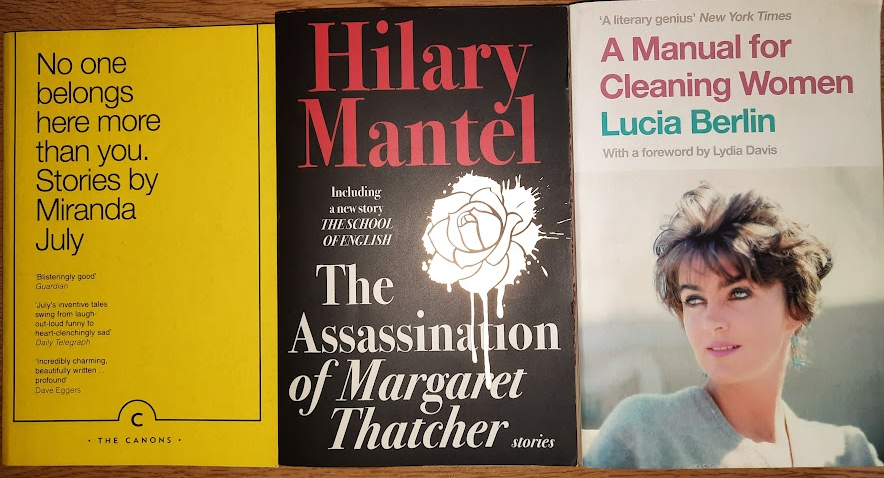Note: The following commentary was written as part of a university assignment during my MA Creative Writing course. It is therefore a bit more on the academic side than the pieces I will be writing in future to accompany my creative work.
For example, whilst I may make reference to works by other authors, I am unlikely to include direct quotations from their work, as I have in this piece. However, I felt it was a good piece to share as an example of my thought process, intentions, and inspirations whilst writing a short story.
Before you read this commentary, make sure you read ‘The Dress’.

Prioritising Dialogue in the dress
When writing my short story ‘The Dress’, I made a conscious decision to prioritise dialogue, and avoid internalisation and description wherever possible. By doing so, I was able to conceal information and delay the unveiling of who the protagonist, Katie truly is, to create a greater impact at the end of the story. By prioritising dialogue, the reader can only interpret what is presented in a scene, with few, or no, other insights. Hence, if a character is insincere in their dialogue, and presents a false version of themselves to another, the reader is likely also misled. Rather than using internalisation to give insight into Katie’s daily life, I have included scenes from Katie’s recent past to demonstrate her personal circumstances; however, I withhold the reveal of her infant child until the final moments of the story.
Use of Immersive Scenes
My story opens with the following exchange of dialogue between Katie and a girl she has encountered in a nightclub toilet:
‘Wow! That’s gorgeous!’ the girl at the sink says.
‘Oh, this?’ I say.
‘You’ve forgotten to take the tag out. Shall I?’
‘Leave it. Keeps that new feeling a bit longer.’ I tuck it under the fabric.
‘If you say so.’
With this, I hoped to land the reader in the middle of the action, with no introduction to the scene, making them work out what is happening from the dialogue alone. For this opening, I took inspiration from Miranda July’s stories ‘Mon Plaisir’ and ‘Birthmark’. Like ‘The Dress’, both of these stories open with dialogue, however, this is done to an even greater degree than my own, as July uses uninterrupted dialogue, without any other action, or assigning speakers. For example, ‘Mon Plaisir’ opens:
It’s lovely.
I know, but take it off. I want a chin-length bob.
You don’t want to go a little bit shorter? What if I cut it to here, to your ears?
You think that would be better?
No, but then you’d be losing more than ten inches of length, and we could give it to Hair for Care. It’s a charity that makes wigs for kids with no hair.
Although the opening of this story is entirely made up of dialogue, with no descriptions or internalisation, the setting of a hair salon, and the relationship between the characters, as hairdresser and customer quickly become clear, demonstrating how dialogue alone can drive a story. In fact, by omitting any descriptions or interjections from the writing, the scene progresses more seamlessly, as its movement does not need to pause for the inclusion of these surplus details. Likewise, the beginning of ‘Birthmark’ lands the reader in the middle of a consultation, opening with the dialogue:
On a scale of one to ten, with ten being childbirth, this will be a three.
A three? Really?
Yes. That’s what they say.
What other things are a three?
Well, five is supposed to be having your jaw reset.
So it’s not that bad.
No.
While it is easy to infer from the dialogue that this is a medical appointment, the precise circumstances of the scene are less clear in the opening than in ‘Mon Plaisir’, as the treatment (birthmark removal) to which they are referring is not revealed until the following paragraph. However, much like with my own story, the title provides a clear hint. Although the title ‘The Dress’ is indeed a big giveaway, in my opening paragraph, I do not disclose exactly what the characters are referring to, calling it only ‘this’ and ‘that’ in their dialogue. Hence, I hide this information similarly (although to a much lesser degree) to how I conceal that Katie is a teenage mother throughout the story.
Character Ideation
The idea for my main character, Katie came from the concept of a paradoxical protagonist. On the surface, Katie is a teenage girl, who enjoys going out to nightclubs; however, she is also a single mother, struggling to support her infant child, both financially and emotionally. Of course, this detail is not revealed until the very end, despite making multiple references to ‘Oliver’ throughout the story. While I have tried to avoid exposition through dialogue, I have used it to plant clues and to mislead the reader about Katie’s personal life. For example, Oliver is first mentioned in the following exchange between Jen and Katie, in a flashback scene from earlier in the night:
‘[…] How’s Oliver doing?’
‘I’m a bit sick of him. I know that sounds awful. But living with just him… it’s intense. Like we’re in a bubble.’
With this dialogue, and with later references to Oliver also, I purposely mislead the reader into believing that he is Katie’s boyfriend. They should get the feeling that he is possessive of Katie, and that she has become rather isolated since living with him. This is furthered when she reveals that her parents have cut contact with her, giving the impression that they have done so because they disapprove of her relationship, when actually, it is because they disapprove of her having a baby so young. I come close to revealing the truth in the following dialogue between Katie and Oliver’s father, Luke, in the nightclub:
‘Just come meet him,’ I say.
‘No. For the last fucking time.’
I want the reader to feel that there is something off about this exchange, which hints that there is something else going on between these two characters, other than them being romantically affiliated in the past. The reader should have questions about who Katie is referring to, and why she is so determined for Luke to meet him. From the Ikea flashback scene, it is already understood that Katie has been attempting to contact Luke and that he is unwilling to speak with her, but the reason for this is unknown.
Misleading the Reader
When planting the seeds of the reveal of Katie’s baby in ‘The Dress’, I considered the short story ‘Mrs Fox’ by Sarah Hall. From the very beginning of the story, Hall hints at what is to come, with details such as, “she dreams subterranean dreams, of forests, dark corridors and burrows, roots and earth.”, which demonstrate Sophia’s natural habitat as a fox. Similarly, in the short story ‘Starver’, Daisy Johnson misleads the reader into believing that the narrator’s sister has an eating disorder, not revealing until the final moment that she has actually turned into an eel. Of course, the reveals in both Hall and Johnson’s stories are far more whimsical in terms of subject matter than my own, but the tools of delaying and misleading the reader in these stories apply to my work regardless. Like Hall and Johnson, I give physical clues about the truth, through my references to Katie’s torso. Right at the beginning of the story, I write, ‘In the mirror, my eyes fixate on my middle.’, showing that she has an issue or at least a ‘fixation’ with her body. This is addressed again later, in the following exchange between Katie and Chris, when they have gone back to his house after the nightclub:
His hands drop down to my thighs, push under the fabric and graze my stomach. I jerk back.
‘What’s wrong?’ he says.
‘Nothing. Just… don’t touch my stomach.’
‘Why not?’
‘I just… I don’t like it.’
‘Okay…’
The reason why Katie is self-conscious about her body is that she has a post-partum belly, however, she could have had body issues anyway, so this clue about her being a new mother can easily be dismissed. Later in this scene, Katie comes close to telling Chris that she has a child. This exchange goes:
‘I shouldn’t have come. I’ve got a… a…’
‘A boyfriend?’
‘No.’
‘So, what’s the problem?’
‘I just… I need to go.’
Here, the reader should believe that Katie is lying about having a boyfriend, since it has been established that there is an ‘Oliver’ in her life. However, Katie is telling the truth and is actually experiencing a brief moment of guilt for leaving her baby home alone all night. The incident (or series of incidents) with her dress has reminded her of her responsibilities as a mother, as with the dress now destroyed, she will not be able to return it, and therefore will not be able to pay her rent, putting both her own and her child’s security at risk.
Use of Internal Narration
The final section of my story, starting when Chris deserts Katie by the side of the road, is quite unlike the rest of the story, in the fact it is told through internal narration. I want this shift to be noticeable to the reader, both visually (in terms of on-page formatting) and tonally, after reading so much dialogue between Katie and various other characters, to highlight the fact that she is now on her own. It is only here that we get a true glimpse into her daily life: the isolation she endures, and her financial and emotional struggles as an unsupported teenage mother.
Conclusion
By prioritising dialogue in ‘The Dress’, I have been able to conceal and delay the reveal of information about my protagonist. By minimalizing description and internalisation, I encourage the reader to pay closer attention to the subtext of the dialogue, as they get to know the characters predominantly through what they say. Moreover, by carefully omitting details and using ambiguous phrasing in my dialogue, I deliberately mislead the reader about Katie’s home life, to create a greater impact when the truth is finally revealed. Furthermore, I have used a dialogue-oriented writing style to highlight the shift at the end of the story, when the dialogue stops, to illustrate how isolated Katie is in her day-to-day life, living alone and unsupported with her infant child.
Points of Reference
Throughout this commentary I reference stories from the following collections. Be sure to check them out if you’re looking for some interesting short reads!
- Madame Zero, by Sarah Hall
- Fen, by Daisy Johnson.
- No one belongs here more than you, by Miranda July.
Other collections to note include:
- The Assassination of Margaret Thatcher, by Hilary Mantel
- A Manual for Cleaning Women, by Lucia Berlin


Pingback: The Dress – A Short Story - Emma McCartney
Pingback: Character is Plot - Emma McCartney
Here, I’ve read some really great content. It’s definitely worth bookmarking for future visits. I’m curious about the amount of work you put into creating such a top-notch educational website.
Ny weekly Very well presented. Every quote was awesome and thanks for sharing the content. Keep sharing and keep motivating others.
Real Estate This is really interesting, You’re a very skilled blogger. I’ve joined your feed and look forward to seeking more of your magnificent post. Also, I’ve shared your site in my social networks!
BaddieHub You’re so awesome! I don’t believe I have read a single thing like that before. So great to find someone with some original thoughts on this topic. Really.. thank you for starting this up. This website is something that is needed on the internet, someone with a little originality!
FinTechZoomUs Awesome! Its genuinely remarkable post, I have got much clear idea regarding from this post . FinTechZoomUs
Sportsurge very informative articles or reviews at this time.